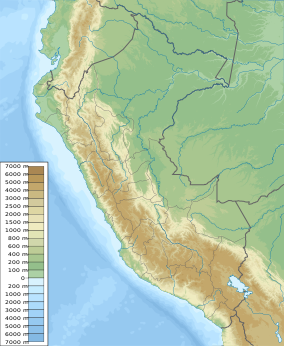
Sunchubamba Game Reserve
| Sunchubamba Game Reserve | |
|---|---|
| Coto de Caza Sunchubamba | |
IUCN category VI (protected area with sustainable use of natural resources) | |
| Location | Cajamarca |
| Coordinates | 7°31′43″S 78°29′06″W / 7.528651°S 78.485041°W |
| Area | 597.35 km2 (230.64 sq mi) |
| Established | April 22, 1977 |
| Governing body | SERNANP |
| Website | Coto de Caza Sunchubamba |
Sunchubamba is a game reserve in the region of Cajamarca, Peru.

History
The area of the reserve was formerly part of Casa Grande hacienda which was closed in the past century due to the low prices of sugar and the Peruvian agrarian reform.[1] The present protected area was established in 1977.[1]

Geography
Sunchubamba Game Reserve is located in Cajamarca Province, in the region of Cajamarca.[1] Its spans an area of 59,735 hectares (597.35 km2).[1]

Ecology
Flora
Plant species from native forests in the area include: molle (Schinus molle),[1] aliso (Alnus acuminata),[1] Festuca dichoclada,[2] Solanum sanchez-vegae,[3] etc. There are also more than 500 hectares of plantations of introduced species like: Grevillea robusta, Pinus radiata and Cupressus spp.[1]

Fauna
Animals considered game in this area are: the native white-tailed deer and the introduced red deer.[1] Minor game are: the black-winged ground dove and the Andean tinamou.[1]

The red deer was introduced for the first time in 1945 (3 individuals), but the locals killed them because they were afraid of how they looked like.[4] In 1948, other 30 red deer were introduced and by 1972 there were around 200-360 deer in the reserve.[4]

Animals protected in this area include: the tapeti, the Andean fox, the vizcacha, the variable hawk, the American kestrel, the aplomado falcon, etc.[1]

Activities
Trophy hunting is the main activity in the area.[1] Scientific research has also been carried out in the area, even before its designation as a game reserve: a cloud seeding program was performed in the 1950s and 1960s at the then hacienda and surrounding areas as part of a program to fight drought in the region.[5]

References
- ^ a b c d e f g h i j k "Sunchubamba - Servicio Nacional de Áreas Naturales Protegidas por el Estado". www.sernanp.gob.pe (in European Spanish). Retrieved 2017-05-11.
- ^ Stančík, Daniel; Peterson, Paul (2007). "A Revision of Festuca (Poaceae: Loliinae) in South American Paramos". Contributions from the United States National Herbarium. 56. Smithsonian Institution Scholarly Press: 46.
...on Sunchubamba–San Juan road...
- ^ Knapp, S. (2010). "Four New Vining Species of Solanum (Dulcamaroid Clade) from Montane Habitats in Tropical America". PLOS ONE. 5 (5): e10502. doi:10.1371/journal.pone.0010502. PMC 2864764. PMID 20463921.
- ^ a b Cossíos, E. Daniel (2010). "Vertebrados naturalizados en el Perú: historia y estado del conocimiento". Revista Peruana de Biología (in Spanish). 17 (2): 179–189. doi:10.15381/rpb.v17i2.25. ISSN 1727-9933.
- ^ Howell, W. (1965). "Twelve years of cloud seeding in the Andes of northern Peru". Journal of Applied Meteorology. 4 (6): 693–700. doi:10.1175/1520-0450(1965)004<0693:tyocsi>2.0.co;2.
External links
Sunchubamba Game Reserve. Official site (in Spanish).

Sunchubamba Game Reserve. Official map.

Sunchubamba Game Reserve. Google maps 3D view.

Video of American kestrel in Sunchubamba.

See what we do next...
OR
By submitting your email or phone number, you're giving mschf permission to send you email and/or recurring marketing texts. Data rates may apply. Text stop to cancel, help for help.
Success: You're subscribed now !

